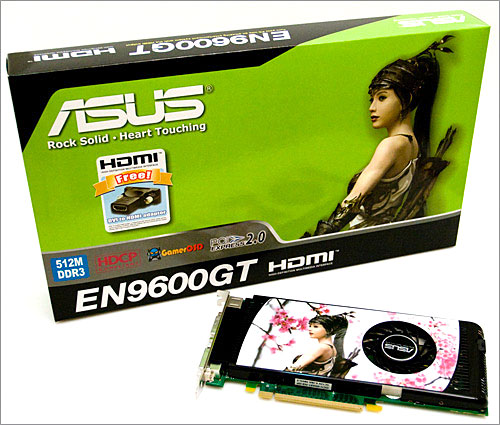NVIDIA GeForce 9600 GT Launch and 3-Way Shootout
Asus EN9600 GeForce 9600 GT
Despite being the largest of the three companies in our GeForce 9600 GT shootout, along with the one with the most amount of resources for custom card designs, Asus has gone the safe route this time around, as their EN9600GT card is based on the stock NVIDIA reference design with no changes whatsoever. Well, of course, unless you consider the lady in front of cherry blossoms a change for the better. If nothing else, it’s nice to see something graphically different beyond spaceships, aliens, and soldiers, though we can’t see this design wooing a great deal of gamers out there.
The EN9600 GT features NVIDIA’s G94 graphics processor at a stock clock of 650 MHz for the GPU along with 1625 MHz for the shader clock. The GPU is connected to 512 MB of GDDR-3 memory which is also clocked at stock levels of 1,800 MHz. This gives the card 57.6 GB/s of memory bandwidth, which is certainly not bad for a mid-range card, but is quite a bit less compared to other cards in our shootout. The reference clock speeds which Asus has decided to go with in comparison to the other cards which are overclocked means that right off the bat, this will likely be the slowest card of the bunch. However, it’s also the most likely to hit at NVIDIA’s $189 price point, whereas the other cards will likely hit $200+.
The EN9600 GT uses the NVIDIA reference single slot cooling system, identical to that of the majority of GeForce 8800 GT cards on the market today. The cooling system utilizes an array of a copper base, copper heatpipes, and aluminum alloy thin-fins to rid the GPU of all that nasty heat, and it does it all in a single-slot design. The EN9600 GT is a quiet card, even under heavy load, and will likely be inaudible in a closed chassis environment. Since the card runs at slower clock speeds, it doesn’t tax the cooling system as much. During testing, we did not hear the card spin up to more than its lowest fan level.
 Asus EN9600 GeForce 9600 GT - Left |
 Asus EN9600 GeForce 9600 GT - Right |
The card is equipped with two dual-link DVI ports along with an S-Video/HDTV output port. Asus also bundles a DVI to HDMI adapter with their board, which can be connected to an audio source via a 2-pin S/PDIF cable to provide full audio and video through HDMI. Other standard features like PCI Express 2.0 support and PureVideo HD support are certainly in the mix as well. The board requires a single 6-pin PCI Express connector to run, and a power adapter is bundled with the board.
One of the side benefits of running at a lower stock clock speed is that the card runs fairly cool, even with NVIDIA’s single-slot cooling system. Our Asus EN9600 card was able to idle at just over 110ºF, whereas it hit a peak temperature of 144ºF under sustained load, 10ºF cooler compared to eVGA’s card which uses an identical cooling system.
While the card’s clocks aren’t super impressive out of the box, that does not directly affect its overclockability. The Asus EN9600 GT card was able to hit a peak GPU clock speed of 750 MHz and retain full stability, which is a 15% boost in raw rendering power. The card's memory was even more impressive, as it was able to overclock up from 1,800 MHz to 2,200 MHz, which was actually an even larger percentage gain at 22%. This overclock gave the card peak memory bandwidth levels of over 60 GB/s, which allowed for noticeably better performance in high-end games.
All in all, the Asus EN9600 card provides the performance and features that one should expect from a reference GeForce 9600 GT card. It’s got a couple nice extras, and our particular unit overclocked quite well. If they can keep the price down, this card should move off retail and etail shelves.







